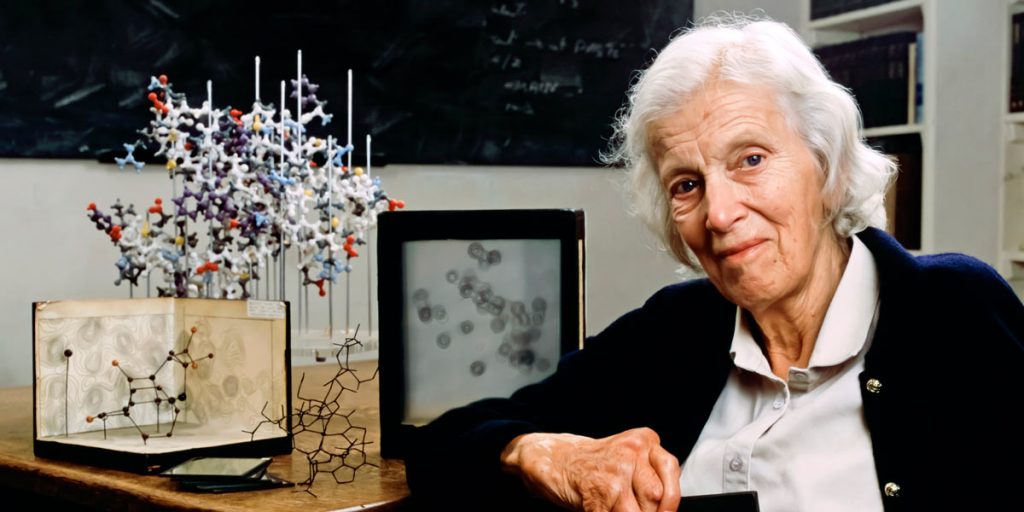Dorothy Crowfoot Hodgkin (May 12, 1910 – July 29, 1994) was a true pioneer in x-ray crystallography – She wanted to get a look at biologically-important molecules, but the technology didn’t exist to do it – so she developed it. And used it to harness x-rays to solve the structure of increasingly complex molecules including the antibiotic penicillin in 1945, vitamin B12 in 1955 (90 atoms), and – her lifelong goal – the hormone insulin in 1969. She won the Nobel Prize in Chemistry in 1964 – the 3rd woman to do so – you might know that – but did you know that she also won the Soviet Union’s version of the Nobel Peace Prize? In addition to an incredible scientist, Hodgkin was active in opposing nuclear weapons and, in addition to advocating for women in science everywhere, she directly mentored several female scientists who went on to become influential crystallographers in their own right.

X-ray crystallography is a technique used to study the structure of molecules that are way too small to see with the naked eye, too small to even see with a light microscope. Instead of visible light (whose wavelengths are too long), it uses a much more energetic form of light – x-rays, which have much shorter wavelengths, better-suited for probing the small distances between a molecule’s linked atoms (individual carbons, hydrogens, oxygens, etc.). But that energy comes at a cost – x-rays can’t be focused with lenses like visible light can, so scientists have to work backwards from the “jumbled” x-rays that scatter when they hit a molecular crystal – and Dorothy Crowfoot Hodgkin largely made this possible!
Dororthy Crowfoot was born the eldest of four sisters on May 12, 1910 in Cairo, where her father worked for the Ministry of Education as an archaeologist and historian. She was raised in England and colonial North Africa and was fascinated by crystals from a young age, a fascination encouraged by her family and family friends – one such friend who was a soil scientist gave her a surveyor’s box of reagents and minerals she could explore with, and her mother gave her a book about X-ray crystallography by Henry Bragg when she was 16. She attended the Sir John Leman School in Beecles, England, where she and her friend Norah Pusey were the only 2 girls in their chemistry class – and they were only there because they had petitioned the school to take it instead of “domestic science.”
Ever since Bragg’s book introduced her to x-ray crystallography, Dorothy was eager to try it out. Since she was only 16 at the time, she’d have to wait. But, at the age of 18, in 1928, she enrolled at Oxford University to study chemistry and for her doctoral studies she enrolled in Cambridge where she had a great mentor, J. D. Bernal. In addition to teaching her crystallography, Bernal provided a welcoming and supportive environment for female scientists, helping make crystallography one of the only fields hiring many women at the time.
Together with Bernal, Dorothy studied the x-ray crystallographic patterns of overs 100 steroids – at this point they weren’t trying to distinguish individual atoms, but rather to get a better sense of their overall dimensions and qualities. But, developing techniques and methodologies as they went, they began to take on larger, more complex, molecules, and higher and higher resolution.
In 1933, she received a research fellowship from Somerville that would support her work for one year at Cambridge and a second year at Oxford. So, in 1934, she returned to Oxford, where she would remain for the rest of her career – as an Official Fellow and Tutor in Natural Science, then a University lecturer and demonstrator (1946), a University Reader in X-ray Crystallography (1956), and a Wolfson Research Professor of the Royal Society (1960). Among other honors, she was elected a foreign member of the American Academy of Arts and Sciences (AAAS) in 1958 and a Fellow of the Royal Society in 1947. I don’t know much about how the British academic system is set up, but sounds impressive. And her work was impressive. Really impressive. As a pioneer of macromolecular crystallography, she developed techniques to “look” at biochemical molecules like vitamins, hormones, proteins, and pharmaceutical drugs – things much smaller than had ever been looked at before – at the “atomic level.”
In 1945, Dorothy Crowfoot Hodgkin solved the structure of the antibiotic penicillin with the help of her graduate student, Barbara Low – at a time it was greatly needed. It was in the midst of World War II, when battlefield wounds and infections were rampant, and knowing the structure helped chemists develop modified versions of penicillin to treat a wider range of infections (and Hodgkin figured out the structure of many of those modified versions as well). She would go on to solve the structure of other biologically-important molecules including vitamin B12 and insulin, developing the methodology to do so as she went.

In addition to fostering her love of science, her mother, who had lost all her brothers in WWI, influenced Dorothy’s political and philosophical leanings. A vocal advocate for world peace, Dorothy campaigned against the Vietnam War and spoke out against nuclear weapons, even serving as president of the Pugwash Conferences on Science and World Affairs, an organization formed to oppose the proliferation of weapons of mass destruction. She received the Soviet’s equivalent of the Nobel Peace Prize, the Order of Lenin, in 1987. Dorothy believed that international conflicts should not impede science – instead, she urged international scientific cooperation, helping found the International Union of Crystallography and insisting that, even during the tense times of the Cold War, Soviet & Chinese scientists be included.
Speaking of differences in political opinions, while working at Oxford in the 1940s, Crowfoot served as a tutor to the future, conservative, Prime Minister Margaret Thatcher – despite their different political leanings, they maintained a strong relationship, with Thatcher inspired by Hodgkin’s position as a powerful woman. As Prime Minister, Thatcher displayed a photo of Hodgkins, and a play (titled “The Chemistry Between Them”) was even written about their relationship by Adam Ganz.
While Thatcher achieved fame as Prime Minister, Dorothy achieved fame when she won the Nobel Prize in chemistry in 1964. The award was for “her determination by X-ray techniques of the structures of biologically important molecules” – primarily for solving the structure of vitamin B12 (and the crystallographic methods she developed to do so – methods that would go on to help researchers around the world solve the structures of countless molecules). The culmination of 8 years of work, solving this structure in 1955 was a tremendous achievement – both for its size (it was by far the largest & most complex structure solved to date) and its biomedical relevance – vitamin B12 is an essential nutrient that can be used to treat pernicious anemia, a disease caused when people’s bodies can’t take in an process its precursors.
Scientists clearly saw the value of her work, but some in the general public seemed to be more fascinated in her gender – with tabloids reading things like “Oxford Housewife Wins Nobel Prize” & “Nobel Prize for British Wife,” and reporters asking about how she managed to do all that scienceing with a busy domestic life.
Dorothy did lead a busy family life – she married Thomas Hodgkin in 1937, a historian who focused on African and Arab history and politics and directed the Institute of African Studies at the University of Chana. They had three children (and Dorothy’s lab notes include measurements of her babies’ growth rates). Their eldest son became a mathematician, their younger son, a botanist/agriculturalist, and their daughter a historian. Dorothy Crowfoot Hodgkin retired in 1977 and died July 29, 1994, but her legacy lives on, including through the work of prominent female crystallographers whom she mentored, including Barbara Low and Jenny Glusker. Dorothy worked at a time when women lost fellowships and research grants when they married, with their funders claiming the women were now “living at home” with their spouses providing for them – Dorothy spoke out against these ludicrous policies, portioning for individual affected women when the issue arose time and time again.
Photo credit: Royal Society of Chemistry
